It’s a fact. Bees love trees. They love to swarm, hive, forage, and pollinate the trees on your property. The number one question we get from customers with bees in trees is “Will the bees go away on their own?” The answer is not a simple one. “It depends” is my usual reply.
Let me explain. No one can predict mother nature, or what bees will do. That being said, there is a chance the bees may go away on their own. You see, sometimes the queen lands to rest. Sometimes she decides to stay and build a hive.
Although no one can predict whether bees will leave on their own, a good rule of thumb is that the longer the bees stay, the less likely they are to leave. Once they have started building hive material, they are less likely to abandon their home. When bees are just resting, they usually take flight within 24 hours. It’s rare for them to leave after a few days because they have usually started building hive material.
There are some exceptions to this rule. One exception is when the bees infest inside a knot hole, or crack inside the trunk of the tree. Another is when they burrow in the ground under the root system of a tree. Once a colony has invaded a knot hole or the root system of a tree, it’s important to take action immediately. Do not wait. Bees inside knot holes and roots systems in trees are very difficult and costly to solve, if not taken care of immediately.
Take a look at the video above. It’s a great clip of a small hive being removed from a tree limb. The hive was approximately 20 feet up and hanging off a branch above a parking lot. It was about the size of a soccer ball and had been in the tree for about 10 days. The property managers were hoping the bees would go away on their own, but the bees had different plans.
In the video clip you will notice we were able to remove the hive alive. Later the colony was relocated to the bee clinic where they were re-queened and relocated to a farm.
Ever had bees in a tree on your property? Did they go away on their own? Tell us your story.

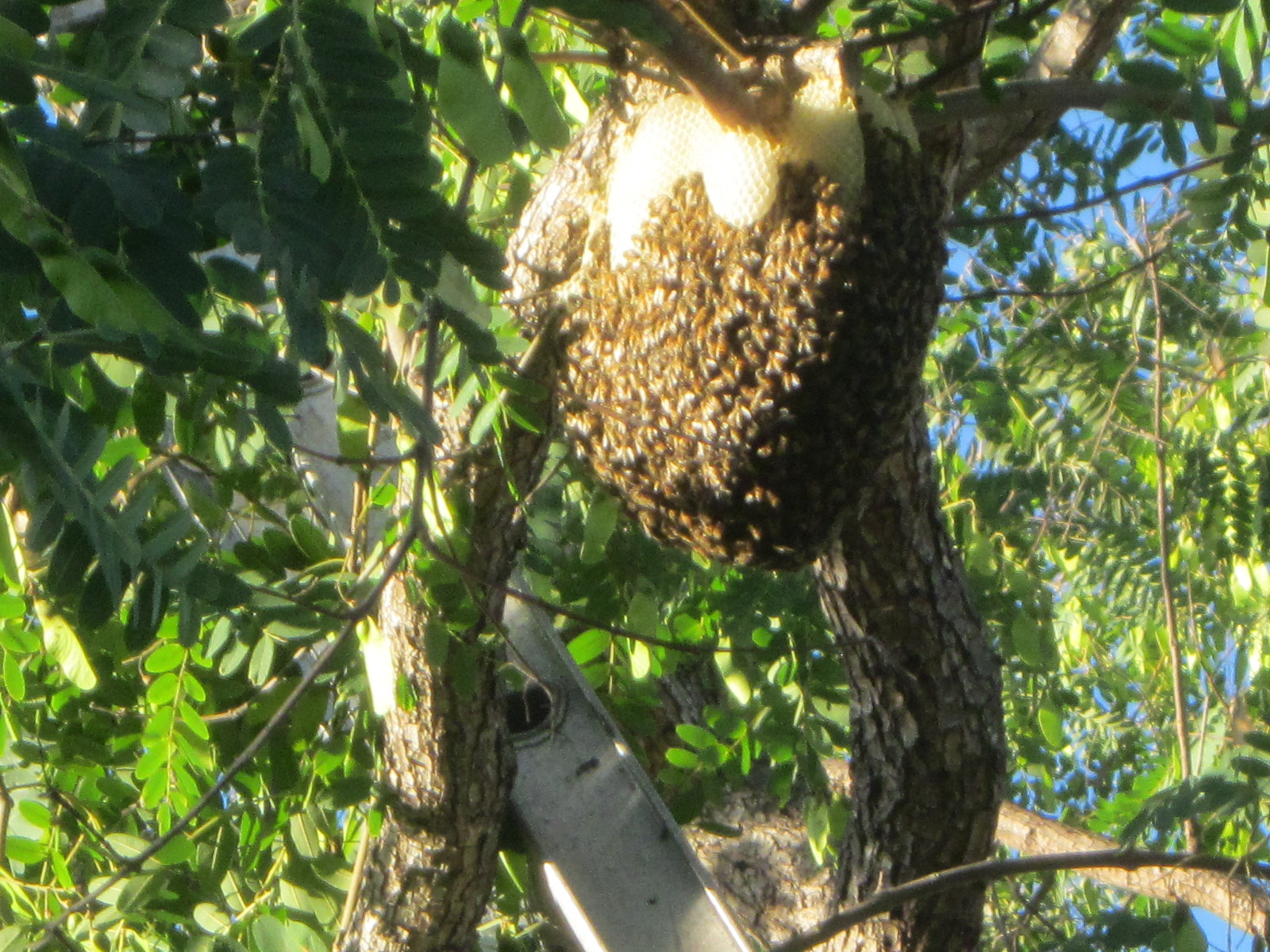

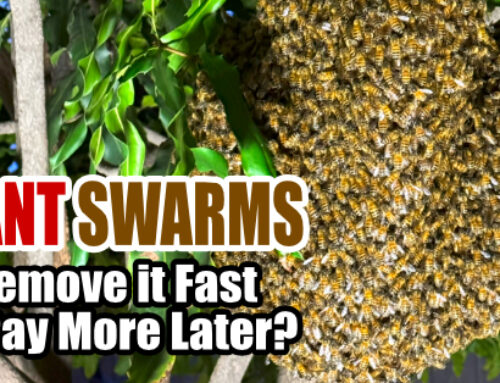
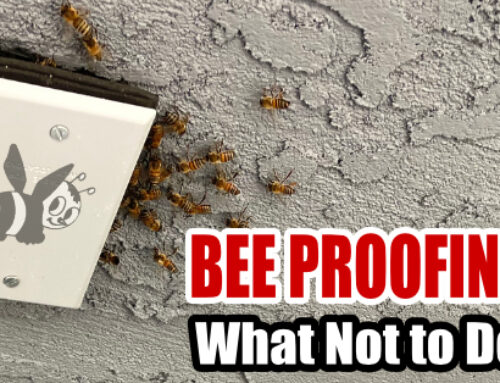
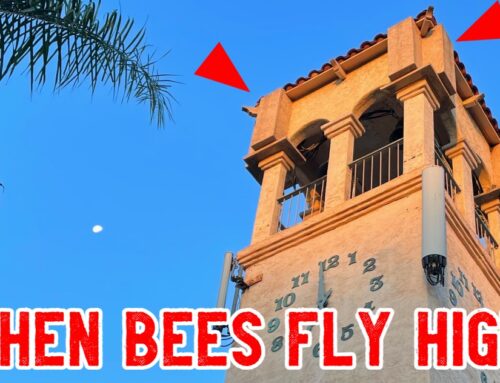
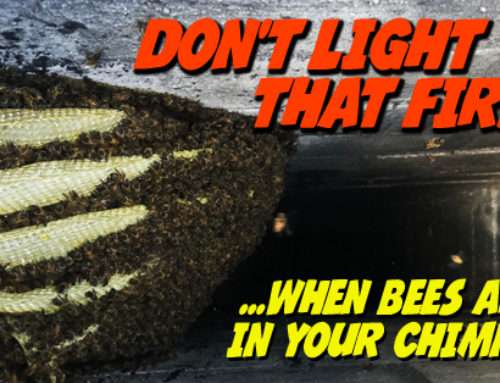

My old dead tree broke in half and the bees are still inside–who can I call to get them removed to a new spot without killing them?
You always want to call a bee professional to come out an assess the situation. Trees can be very difficult to remove bees alive from. As every situation is different when it comes to many bee removal jobs… the specialist may need to take heavy power tools to the tree such as chain saws to get into the tree. This can possibly damage the tree to a point where you will also need a tree removal person to come out after the bees are gone.
The bee specialist should also take precautions to ensure that surrounding residents and animals aren’t stung in the process of removing the bees from the tree. In southern California we have to make public safety our #1 priority since many of our bees are of a hybrid type and can get aggressive very quickly. I wish you the best of luck with your situation.
It is now winter and I had bees in my tree the whole summer this is just a regular tree nothing sweet on it that I know of. And There was no behive or hole in the tree. They are gone for now but What do you think may have kept them on my tree and will they come back next year
Hi Tony. It’s possible there may be a hive inside a knothole, or under the root system of the tree. If that is the case, a new swarm may re infest the tree again. The bigger the hive inside, the quicker and more likely it will become re infested.
Hiya I have tree bees in a hole above my bathroom window I’ve recently noticed dead bees on the floor will they stay long as the constant buzzing noise is driving me mad I’ve noticed theres a wierd smell in the bathroom too
Hi Donna. There is a chance there is a hive that is actually inside the wall or structure of your home. What you may be seeing are the bees from that colony are now pollinating the tree. Best to call a Bee Removal Company in your area to perform an inspection.
I have a young oak tree, about six feet tall that a swarm of bees have landed in and stayed. After conversation with a local bee relocator, i was assured they don’t live on a tree branch. He stated they were in transition so I hoped they would travel on their own. Over ten days later they are still there, even lower in the tree, on a branch less than three feet off the ground. Today we can clearly see a wax hexagonal hive. We are breeders of very large dogs and I am concerned about the bees aggression as they get protective of the hive. Can we build a wooden hive and transfer them? Why would they build here out in the open with no protection from weather, my purple Martin colony, or ten 150 pound dogs at eye level?
Hi Nikki,
It’s hard to say why the bees have chosen to remain in your tree. That being said, it is not unusual for bees to build hives in trees. The person who told you they would go away should have informed you that there is also a good chance the bees may stay.
You see, it is a myth that bees will always leave a tree and go somewhere else. Too often we hear misinformed people say “Leave the bees alone!” “The queen is just resting!” and “They will go away on their own!” Although these statements are often true, it is not always a certainty that the bees will leave. What I usually tell people is this: “The longer the bees remain, the less likely they will go away on their own”.
At this point, the bees in the tree are probably still a good candidate for live removal. You might want to reach out to that beekeeper again and clarify the communication regarding what can be done to solve the bee problem.
We noticed some bees coming to one of our motion sensing lights occasionally in the mornings (we have outside cats that wait at our door for their AM meal which caused the light to come on which then attracted the bees). We need to redo our backyard privacy fencing and yesterday had a tree company come to take a tree down that kept having its branches damage our fencing. It was during the cutting down of this tree that we finally found the hive. So now the bee hive is still alive but more exposed. It is located in a wooded area on an adjacent property but only about 10 feet from our yard. Should the hive be removed or will the bees relocate themselves due to the change in their environment?
Hi Holly. It’s impossible to predict mother nature. Most of the time, bees wont abandon a hive, once it is fully established. In this case there may be a chance that they will move on, since the area around the hive was disturbed. If the bees do not move on, you may want to contact a professional to remove the hive, especially if you live in a region where the feral bees might be africanized.
Have a honey bee hive in a tree in my backyard about 40 feet high and it has been there for over 5 years with no problem.
Yes. Sometimes bees will stay in a tree, especially when they are 40 feet up. The higher up they are, the more protected they feel from normal human intervention.
Just found a hive in the flimsy outer branches of a Ficas tree. It doesn’t look sturdy enough for the hive to get much larger than the soccer ball size it is now. Will the bees leave this scenario because it’s so flimsy? If I weaken the branch more (safe distance) will it encourage the bees to leave?
Hi Sandra, if the branch is weak, there is a good chance the bees will go away on their own. Unfortunately, they might also move to a different spot on the tree that is sturdier.
We don’t recommend you take action or disturb the bees. Although that might work, it could also make things worse. The bees could move higher up on the tree and/or move into a vent or eave on your home. Your intervention could also potentially trigger the bees to attack you, your neighbors, and/or other animals walking nearby. If the bees don’t move on their own, best to call a bee professional.
Hopefully from what I’ve read it’s okay to leave bees that are swarming on the tree trunk alone, especially since they are in the front yard where no one will disturb them.
When it comes to bees on trees, lot’s of people choose to wait to see if the bees will take flight and move somewhere else. As long as there is no threat to the safety of people or pets in the area, waiting a day or two cant hurt (unless they are Africanized). If the bees haven’t left after a week, its usually best to call a professional to remove the swarm, before they build a beehive.
WE had a swarm of bees that landed on our large backyard tree. I only discovered it because I was suddenly surrounded by them like a crazy cyclone of debris. Needless to say, I ran and left the mower. I recall seeing a single bee by my backdoor light fixture about 3 or 4 days before then and thought that was odd. The evening of the found swarm, there were about 8 single bees scoping out the back patio light and door again. I sprayed vinegar around them hoping the smell would make them disappear. It didn’t. The next morning I looked up scents that bees don’t like. Citronella was one of them, which I happened to have, so I lit the candles and left them to burn. Within about 3 hours, the swarm was gone, as were the little guys scoping out my back patio wall and light.
The huge swarm is gone, but there are remainders of about 10-15 still moving about on the branch, and there is whitish stuff on the branch. Are these bees building something, harvesting something that was placed there when the swarm was there, or might the swarm return? I can’t tell what it is. The branch is maybe 2 to 3 inches in diameter and about 10 ft above the ground.
Hi Suzanne. Based on your description, it sounds like the bees abandoned the very beginnings of a hive. The white color suggests that they had built the wax cellular material, but not yet produced any honey. If it was an established hive, you would see a dark yellow/amber honeycomb.
On Monday evening we noticed 20-40 bees flying around our backyard patio and going in a hole under second story siding where it meets brick. The next day we used a pole to put peppermint oil via cotton balls next to entrance and like 20,000 bees flew out. We left the oil there and the bees have not re-entered although they want to. However, now they formed a swarm ball in top of backyard tree. They are still flying around trying to get in hole but won’t go near the peppermint oil. Since we were outside all day and night Sunday and didn’t see any bee activity I really think they were in the siding less than 48 hrs. What do we do now? We have reapplied oil and it’s working. Do we seal up hole? Will they move on?
Hi Sterling,
Sounds like you have taken control of the situation and might be on your way to solving your own bee problem. You ask if you should seal up the hole where the bees were entering the structure. My best advice is to use caution and seek the advice of a professional. You see, you don’t want to accidentally seal a swarm inside the structure. If there are still bees inside (and they have no way to get back out the way they came in), they might flood the interior of your home. We get many emergency calls from people who who seal the holes before eliminating or removing the bees. Really is best to have a licensed professional inspect the area to make sure any work you perform wont make the situation worse.
We have bees in a knothole of a very old protected oak, they are about 10ft off the ground.
They don’t bother us but will they make the tree unstable as is quiet large and about 15 ft from the house?
We had a beekeeper take a look but they said there is no way to get the bees out, they are Cornish honey bees. We have placed a hive nearby but no luck as yet and it’s been over 6 months now.
Any suggestions please?
Hi Vanessa. I wish I had a suggestion to help you with your problem. Unfortunately when bees make hives inside knotholes of trees, it can be very difficult to resolve the problem. Having a hive box nearby (with or without a lure) rarely entices the bees to move. In addition, bee lures often attract new swarms instead of moving the original bee colony. Unfortunately when it comes to bees inside tree knotholes, the bigger the beehive, the more difficult it will be to resolve the problem without cutting down the tree.
I have had bees in a holed out branch of a very large maple tree for a few years now. I keep reading conflicting information…I would like to leave them, is it true they can kill the tree?
Hi Sarah. In the 27 years we have been in business, we have never seen a tree die solely from a hive inside of a knot hole. That doesn’t mean it can’t happen though. We do sometimes we find that there will be decay, mold, rodents, and/or ants that might become a nuisance. That being said, once a hive becomes well established inside the tree, it is hard to remove it without killing the tree. That may be where the confusion lies.
We had a swarm group up on a tree in our smallish in-town yard. Called a bee professional and he removed the queen and the majority of the bees 24 hours after they landed. A group slightly bigger than a softball are still hanging on the tree two days later. How long will they stick around without a queen?
Hi Jose,
It’s impossible to predict mother nature. Sometimes straggler bees go away in a day or two. Sometimes they can stay over a week. If the straggler bees are not gone after 7 days, I would call the bee professional and schedule him to return and remove the remaining bees. Most bee professionals offer a 30 day warranty for swarm removals.
My neighbor has a tree with bees living inside it. i told her about it last year. I am highly allergic. She didn’t do anything then. Now that the weather is warmer, the bees look like millions flying in and out of the tree. I am afraid to go in my backyard. She said she will hang some kind of bags around. I don’t think that will take care of them. Her tree has knobs on it, animals living in it. Leaves are turning black, as they fall into my pool. What can I suggest her to do?
Hi Sue. The situation you describe is actually a very difficult bee problem to fix. It sounds like it could be a dangerous situation, mainly because if you are allergic, one sting could send you to the hospital.
Here is what the County of San Diego recommends on their website:
1. It is the responsibility of the property owner to remove a swarm or nest of bees on private property.
2. The property owner should call a licensed pest control company or experienced beekeeper to have the bees.
3. If they are renting, contact the landlord or property management company to notify them of the bee nest.
4. If the bees are in the water meter, call the local water authority.
If trying to reason with your neighbor doesn’t work, the last resort would be to file a compliant with the City or County where you live.
How fast do these hives form?
I just saw a brown “something” up in a tree branch in a alder tree about 50 feet from my back patio….
Thought it might be a raccoon, or other critter we have lots of.
Paying it a little more attention, I saw lots of bees swarming around it.
I didn’t notice this earlier, and it seems the swarming activity is a lot less, but the mass is still there.
I heard of others having this experience in the area lately too….
Not sure if weather plays a part, been very wet here in the Pacific Northwest, but today is perfect….
Do they move around when the weather is better?
I guess I will just watch for now, not sure if I need to do anything yet.
Hi Ed. Bees can build a fully established beehive in as little as a two weeks. If the bees are partially africanized, sometimes even sooner. If the brown cluster you describe is a swarm, the bees may take flight instead of remaining and building a beehive. Usually if the bees are going to leave, they do so within the first few days. The longer the colony stays, the more likely they will start building a hive.
A swarm just landed in my front tree overnights, I noticed about 1/3rd if them falling and dying on the ground since they landed. The ball of remaining is About the size of a football. Having kids I worry I should call to get then removed.
Hi Beth. If the bees don’t fly away on their own, call a beekeeper to see what they will charge to remove them. You can try to contact a Beekeeping Society in the nearest metropolitan area.
Hi Beth, From what you describe, the colony may have been already been exposed to pesticide. If the bees are still alive and are endangering people, I would recommend calling a pest control company to get rid of them. I would not recommend a beekeeper since the colony might have been exposed to pesticide. A beekeeper will not want to risk pesticide exposure to the other healthy colonies at the beekeepers apiary.
HI, I have a different type of question. About 6 days ago, my backyard pond starting getting about 10-12 bees. In reading up, it appears these are worker bees taking water to a hive? I kept trying to see where they were flying off too, but never could. They were too fast. I only saw the direction they were headed (which was away from my home). so far this morning, I have not seen any for 3 hours. Does this probably mean the hive is gone? Or they moved to a different source?
Well. I take it back. 4 just showed up. (at noon). everyday they have been out there from at least 8am. Not sure why they werent today. Looks like they are here for the long haul. It sucks because I cant go work on my pond or in my backyard. :-#
Hi Nan. I understand your frustration. I get quite a few calls describing exactly what you are experiencing. It’s frustrating because the bees may be a nuisance even though the colony (beehive) is not located on your property. I would try going door to door, in the direction of the bees flight path. Ask the occupants of each property if they have a bee problem (or if they have also noticed bees on their property). If you can locate the hive, you can then begin the process of possibly seeking a new location for the colony.
Hi Nan. The slight reduction of bees might be due to them finding another water source nearby. As we progress out of summer and into the colder months of Autumn, you may notice fewer and fewer bees. If you need to work on your pond sooner, I recommend going out there during the early morning hours (or late evening). The colder it is outside, the less bees will be flying.
Hello,
I have had the same bees come back to my mulberry tree every spring for a couple of years now. They were up in a knot in a branch in the top of the tree but recently we noticed that they were flying in and out of a crack by the main trunk. This is a 30 year old tree and i don’t want to lose the tree. Would it be beneficial to us the peppermint oil or the citronella to get them to leave it is very hard
to even mow the yard with out them chasing you thru the yard.
Hi Dawn. Bees getting inside knotholes of trees can be a tricky problem to solve, especially if the infestation is up high in the top of the tree. I’m not certain if Peppermint or Citronella will persuade the colony to leave the beehive. You could try a licensed pest control company in your area that uses “green” Eco-friendly products. It’s possible they may have a professional grade product that will allow you to mow your yard in a bee free environment.
I had a swarm build a nest with their body’s stayed for 2 weeks they left today left a small honey comb and about 10 bees do I take down the comb or leave it they were about 6 feet from my house never bothered me was really cool
Hi Diane. Sounds like the swarm took flight and left a small piece of comb behind. If the comb is white, it means there is no honey and it should be easy to remove. Just wait until there are no bees (when its cold outside). If the comb is yellow or brown, be more cautious when removing. You want to try to remove it without dripping any honey. Be sure to have a trash bag handy to avoid any honey dripping into the ground below.
Hello Abra, I have bees in the base of the olive tree.. I tried pouring water down the hole, but there seem to be many channels inside the base of the tree but they are still there.any suggestions.
Hi Johnathan. Removing bees and honeycomb from the base of a tree is incredibly difficult. It’s one of the harder problems to solve because you don’t want to kill the tree while in the process of removing the hive. You might want to get the advice of a pest control company, a beekeeper, a tree company (or all three) to see what can be done.
Tiesday, August 6 the day of the heavy rain due tothe Isaisa storm, my neighbors tree branch broke away but not completly and landed on my property. When I checked outside, I also noticed a round surface of a perfectly formed beehive about the size of a medium pancake.
Monday August 10,2020 the neighbor is suppose to remove tje branch. He didn’t mention tje beehive. The beehive had landed on a wire mesh stand that is attached to my grill. Now the hive has a web like covering around it. I also saw a.few bees. What do you think tje bees are up to? The tree is extremely high. Could there be more hives?
Hi Helen. The hive that fell, which you describe as being “about the size of a medium pancake” could be just one panel of a larger hive that is still in the tree. Sometimes when hives become very large, the weight causes a portion of the hive to fall to the ground. So it is very possible that a majority of the hive still remains in the tree above.
All of a sudden a tree that’s not in our yard has bees swarming the tree. Three tree branches are touching our fence so it’s very close to our yard so obviously the bees are coming into our yard. How do I find the rules of who’s responsibility it is to get rid of the bees? I noticed you started about the country of San Diego, but I cannot find it for mine. I live in Lorain county and the city of North Ridgeville. Thanks in advance!
Hi Sara, I would start by contacting the Lorain County Department of Agriculture. They are the most likely government agency to oversee bee issues. If they are not the correct agency, they will likely be able to direct you to the correct department. Hope this helps.
We were having an old dead Oak tree removed from a preserve area behind our house. When the tree guy sawed off a big limb and it fell to the ground the whole area erupted with bees. The limb broke in two upon hitting the ground and we can see the honey comb spilling out of the broken limb. This was two days ago and the bees are still active around the site but don’t bother us as long as we stay away. Any chance these bees will find a new home since the one they had is on the ground and now open to the elements??
Hi Gary. If the entire hive is removed off of the property, the straggler bees should go away in the next week or two. If however, there is hive or honey remaining, it will attract more bees to the area. Best practice is to remove all honey and hive material if possible.
All bees and honey gone in about 5 days. Since the tree limb was on the ground I suspect the honey was eaten by some animal, unless the bees are in the habit of taking the honey and comb with them when they move.
Sometimes bees will remove the honey from the honeycomb before leaving the hive behind. If the comb and wax are also gone, you may be right about an animal taking it away.
I have a 40ft tree(what kind??) and every year when the
leaves com out the aphid do also, but not until June. Then
in August the bees start to show up(many) they are eating
the aphid secretion! When the leaves start to drop the bees move out!There is no bees left,in or around the tree until the same time next year,they aren’t living in that tree nowhere at all, these bees feed off this tree for about a month and a half, and I’m not sure if they are honey bees or not! They aren’t aggressive at all, and I have been here for 30yrs.
I am happy to have a beehive in my oak tree, and would be happy to have our new little residents stay as long as they would like. So, I’m hoping for advice:
We had been talking about taking down a dead sycamore that is right beside the oak tree as well as a couple branches on the oak that have grown out over our neighbor’s house, but now, I am concerned about disturbing our bees.
How sturdy is a beehive wrapped around a branch? Since the hive is quite far out on a branch on the other side of the tree from the proposed cutting, would the shaking of the tree from cutting down a couple other limbs make the hive fall? Would the activity of cutting down the sycamore, etc cause the bees to become aggressive?
Hi Shari. You are right to be concerned. There is a chance that cutting the tree may cause issues with the bees. Depending on where the hive is (and other factors like size and age of the hive), it might be ok to remove the dead sycamore nearby. The safest thing for you to do is to call a beekeeper, pest control operator, or entomologist for a professional opinion to ensure public safety.
WE has a swarm of bee show up in our back yard. It was amazing, and scary kind of like the Hitchcock movie, The Birds” The hum was amazing, They mostly all grouped and hung on to a tree branch. Having kids and pets, we called a beekeeper and he came and got the football sized swarm. The next day he came back and removed a softball sized limp of them. Now two days later we have aggressive “straggler” bees and they are more than annoying. Beekeeper says he won’t come back for a few bees. We can’t use our pool. Hardly can use the yard. I am having less and less good feelings about honey bees. How long with the little stragglers (I call them worse names) last. Thanks.
Hi Bob. Straggler bees can definitely be frustrating to deal with. You can check out the blog we wrote about bees and swimming pools for more information.